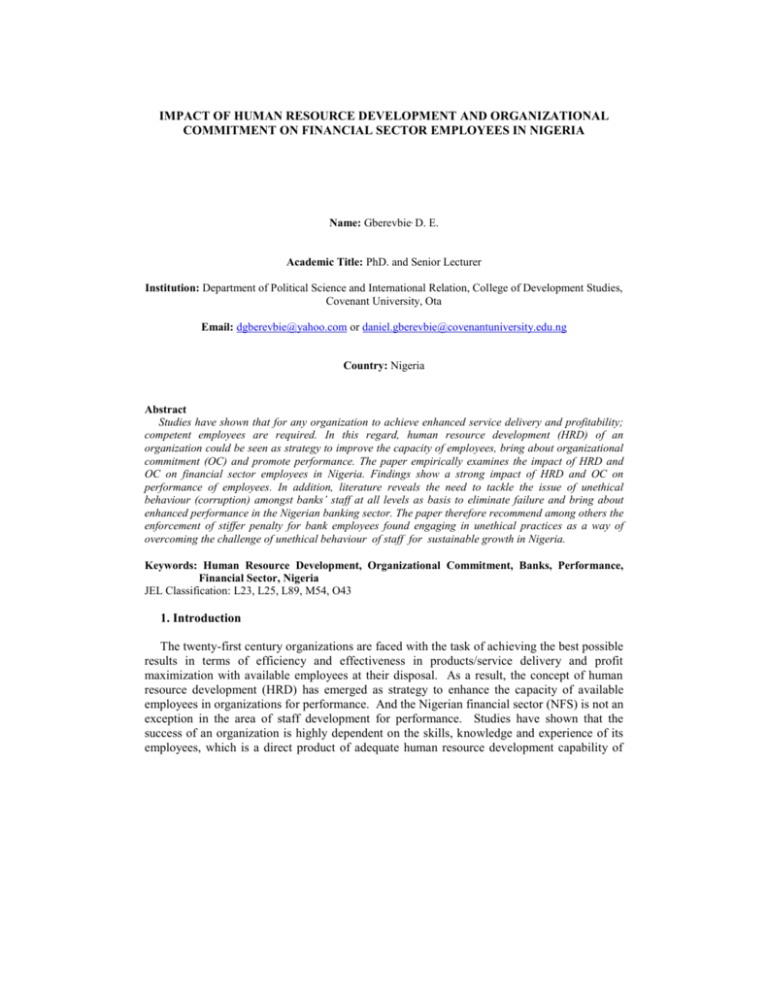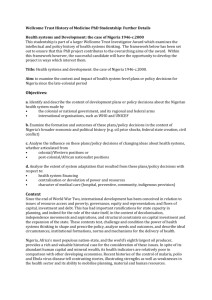Human Resource Development, Organizational Commitment and
advertisement

IMPACT OF HUMAN RESOURCE DEVELOPMENT AND ORGANIZATIONAL COMMITMENT ON FINANCIAL SECTOR EMPLOYEES IN NIGERIA Name: Gberevbie, D. E. Academic Title: PhD. and Senior Lecturer Institution: Department of Political Science and International Relation, College of Development Studies, Covenant University, Ota Email: dgberevbie@yahoo.com or daniel.gberevbie@covenantuniversity.edu.ng Country: Nigeria Abstract Studies have shown that for any organization to achieve enhanced service delivery and profitability; competent employees are required. In this regard, human resource development (HRD) of an organization could be seen as strategy to improve the capacity of employees, bring about organizational commitment (OC) and promote performance. The paper empirically examines the impact of HRD and OC on financial sector employees in Nigeria. Findings show a strong impact of HRD and OC on performance of employees. In addition, literature reveals the need to tackle the issue of unethical behaviour (corruption) amongst banks’ staff at all levels as basis to eliminate failure and bring about enhanced performance in the Nigerian banking sector. The paper therefore recommend among others the enforcement of stiffer penalty for bank employees found engaging in unethical practices as a way of overcoming the challenge of unethical behaviour of staff for sustainable growth in Nigeria. Keywords: Human Resource Development, Organizational Commitment, Banks, Performance, Financial Sector, Nigeria JEL Classification: L23, L25, L89, M54, O43 1. Introduction The twenty-first century organizations are faced with the task of achieving the best possible results in terms of efficiency and effectiveness in products/service delivery and profit maximization with available employees at their disposal. As a result, the concept of human resource development (HRD) has emerged as strategy to enhance the capacity of available employees in organizations for performance. And the Nigerian financial sector (NFS) is not an exception in the area of staff development for performance. Studies have shown that the success of an organization is highly dependent on the skills, knowledge and experience of its employees, which is a direct product of adequate human resource development capability of that particular organization (Rao, 2000a, pp. 24-25; Bokeno, 2011, pp. 25-27). Mohammed (2006, pp. 24-31), posits that “the success and progress of an organization depend on its ability to maximally explore the talent and potentials of its workforce.” And this is more likely to be achieved through the purposeful HRD capability of an organization. According to Rodrigues and Chincholkar (2005, pp. 6-20), “HRD is the process of enabling people to make things happen.” This means that without availability of capable employees (in terms of required skills, knowledge and experience) to make things happen in the area of quality products/service delivery and profit maximization, the enhanced goal attainment of that particular organization becomes a mirage. Researches have shown that one of the major challenges facing modern organizations in the twenty-first century is on how to put in place strategies to motivate and encourage their employees to get committed to organizational ideals and aspirations; and also on how to translate these ideals and aspirations into enhanced productivity of the workforce and the organization (Olowu and Adamolekun, 2005, pp. 86106; Gberevbie, 2010, pp. 113-126). In this regard, Ejiofor and Mbachu (2001, pp. 121-126), point out that “…no other factor is as important as human resource in maintaining corporate stability, development and profitability of an enterprise…” Therefore, the successful mobilization of employees to get committed to the ideals and aspirations of an organization (organizational commitment) for the purpose of enhancing its growth and profitability is sine-qua-non to organizational survival. Kim et al (2005, pp. 171-193), see organizational commitment (OC) as loyalty to the organization and mobilization of all employees in the development of its goals, purposes and infrastructure. 2. Purpose and Objective of Study Previous researches point to a significant relationship between compensation, supervisory support, readiness for change, social relationship, job satisfaction and organizational commitment of the employees in the workplace (Madsen, Miller and John, 2005, pp. 213-233; Khalid, Salim, Loke and Khalid, 2011, pp. 192-198; Anis, Kashif-ur-Rehman, Ijaz-ur-Rehman, Khan and Humayoun, 2011, pp. 7316-7324). However, none of these researches dealt with the impact of HRD and OC of employees for performance in the Nigerian Financial Sector (NFS), represented in this study by banks. Therefore, the objective of this study is to empirically examine the impact of HRD (capacity building) and OC of employees in the NFS for performance. This study hopes to provide insight into the relevance of HRD in the workplace (availability of employees with required skills, knowledge and experience); and how it could lead to OC of the Nigerian banking workforce for higher productivity. 3. Literature Review 3.1. Human Resource Development and Employee Performance Several researches in literature point to the fact that HRD is a vital strategy for the improvement of employees for the attainment of organizational goals of enhanced products and service delivery for the survival and growth of any enterprise either in public or private sector (Riordan et al, 2005, pp. 471-488; Rodrigues and Chincholkar, 2005, pp. 6-20; Paprock et al, 2006, pp. 46-61). According to Harbison and Myers (1964) HRD is the process of increasing the knowledge, skills, and capabilities of all people in a given society or organization. This according to them is done through the process of formal education, on the 1 job through systematic and informal training programme. And also for self development on the part of the individual employee through personal initiative, arising from his/her willingness to acquire new ideas for higher productivity. Probably, what appears to be a comprehensive conceptualization of HRD was given by Rodrigues and Chincholkar (2005, pp. 6-20) as the process of improving, moulding and changing skills, knowledge, creative abilities, aptitude, attitude, values, commitment, based on present and future job and organizational requirements for improved productivity in the workplace. In the same vein, the HRD-SA (2009), describes HRD “as the formal and explicit activities that will enhance the ability of all individuals to reach their full potential” (cited in Moorhouse and Cunningham, 2010, pp. 587-597). Emphasizing the importance of HRD on employees’ improved performance; Riordan el at (2005, pp. 471-488), argue that appropriate, ongoing training enables employees to develop the knowledge required for effective performance in an organization for higher productivity. On their part, Paprock et al, (2006, pp. 46-61), posit that evidences abound from the public and private sectors about the unique role of HRD in bringing about the availability in an organization of competent employees for improved performance. The conceptualization of HRD by the various scholars above point to the fact that it is a medium by which employees in an organization are transformed from their present state, to a desired state of affairs in the area of improved skills and knowledge through training (capacity building) ability for the purpose of achieving enhanced performance of organizational workforce. This means that an organization that lacks the ability to improve its employees in the area of training for required skills and knowledge through the adoption of the strategy of HRD is more likely not to have in its employment the competent manpower needed to achieve its goals of enhanced products/service delivery for profit maximization. The foregoing implies that there is a relationship between HRD capability of an organization and higher productivity of the employees of that particular organization. 3.2. Organizational Commitment and Employee Performance The concept of organizational commitment (OC) and employees’ productivity in an organization has generated an exciting debate amongst scholars and practitioners alike. According to Mowday et al (1979, pp. 224-227), OC is the relative strength of an individual’s identification with and involvement in an organization. On his part, Zangaro (2001, pp. 14-22), sees OC as the act of pledging or promising to fulfill an obligation for the purpose of achieving the goals of the organization. He argues that “a person who is committed to an organization should then be dedicated and have a strong belief in the organization’s goals and values.” These various conceptualizations of OC reveal that a truly committed employee would support the organization to achieve its goals and aspirations without coercion from any quarter. In emphasizing the importance of OC on employee productivity, Meyer and Allen (1991, pp. 61-89), point out that individuals (employees) with higher level of OC have a sense of belonging and identification with that particular organization’s goals and activities, and their willingness to remain a part of the organization. In the same vein, Matthews and Shepherd (2002, pp. 369-375), in their work argue that “committed employees have a strong belief in and acceptance of organization’s goals and values, show a willingness to exert considerable effort on behalf of the organization, and have a strong desire to maintain membership with the organization.” On their part, Golden and Veiga (2008, pp. 77-88), argue that “organizationally committed individuals are far less likely to engage in absenteeism and turnover.” This means 2 that higher productivity is more likely to be recorded amongst employees where OC is present than where OC of employees is absent either in public or private organizations. Scholars have put forward different forms of OC in literature to include: identification or affective (emotional attachment to the organization), loyalty or continuance (perceived costs associated with leaving the organization), and involvement or normative (feelings of obligation towards the organization) (Cook and Wall, 1980, pp. 39-52; Meyer and Allen, 1991, pp. 61-89; Parish, Cadwallader and Busch, 2008, pp. 32-52; Rego and Cunha, 2008, pp. 739-752). According to Cook and Wall (1980, pp. 39-52), identification commitment is focused on the connection and pride employees feel toward their organization, involvement commitment encompasses the perceived contribution an employee makes to an organization and how he or she feels about it. It also includes willingness to help even if it takes additional time or work, and loyalty commitment to the company is determined by assessing an employee’s intentions to leave, particularly if additional compensation were offered by another firm. On their part, Meyer and Allen (1991), see affective commitment as refers to employees’ emotional recognition with, and participation in the organization, continuance commitment refers to a consciousness of the costs connected with leaving the organization, and normative commitment reflects a feeling of obligation to continue in employment of the organization. Anis et al (2011, pp. 7316-7324), argue that the three components of commitment (i.e. affective, continuance and normative) help to define the overall OC of the workforce. If employees in an organization therefore must be determined to work towards achieving the goals of an organization, it is of necessity that they imbibe the various components of OC. It could be concluded therefore that OC enhances the performance of employees in their assigned tasks for the purpose of achieving organizational goals. Performance on the other hand is measured by efficiency, which is conceptualized by the formula (cited in Gberevbie, 2010, pp. 113-126): Efficiency = Cost of Output / Value Input. 3.3. The Nigerian Financial Sector Studies have shown that the financial sector in Nigeria as represented by banks in this paper has continued to play major roles in the accomplishment of Nigeria’s quest for development. This is particularly so in the area of employment generation, business/project financing and its contribution to the nation’s Gross Domestic Product for improved living standard of the people (Ebong, 2000, pp. 1-9; Ojo, 2007, pp. 1-79). The origin of the banking industry in Nigeria could be traced back to 1892 when the first bank – Africa Banking Corporation was established in Lagos by Elder Dempster and Company, a Liverpool Shipping firm (Adeyemi, 2002, pp. 53-71; Kolawole, 2007, pp. 208215; Gberevbie, 2011, pp. 149-158). Between 1892 and now, the Nigerian banking industry has passed through several reforms bothering on structure, procedure, personnel and minimum capital base requirement of banks in a bid to enhance their performance (Adeyemi, 2002, pp. 53-71; Ige, 2006, pp. 5-19). One of the major problems of the banking sector in Nigeria since its inception is the challenge of lack of competent manpower to carry out its roles as facilitator of development in the country (Ndekwu, 1994; Olayiwola, 2009). To overcome the challenge of incompetent workforce, some banks in Nigeria put in place strategies for human resource development to improve the capacity of their personnel and enhanced organizational commitment of their workforce for performance (Access Bank, 2007, pp. 13-24; Afribank, 2008, pp. 25-32; Bank PHB, 2008, pp. 30-33; Intercontinental bank, 2008, pp. 26-31; Oceanic 3 Bank, 2008, pp. 13-17; First Bank, 2008, pp. 42-53; Zenith Bank, 2008, pp. 5-25; UBA, 2008, pp. 36-37). Researches have shown that in addition to the challenges of HRD and OC as basis for the non-performance of the financial sector; other factors have been identified in literature by scholars to include weak leadership and poor business practice in terms of unethical behaviour (corruption) in an organization arising from incompetent and ineffective workforce that leads to poor credit policy of banks, inadequate internal controls and ineffective board/statutory audit committees, which are some of the major reasons why some banks in Nigeria face the problem of distress. This situation has made it almost impossible for some banks to accomplish their roles in the developmental drive of the Nigerian economy in terms of job creation, business/projects financing, enhanced company tax to the government, carrying out regular corporate social responsibility of the provision of welfare services to host communities and regular/higher dividend to shareholders (Hopkins, 2001, pp. 120-129; Dogon-Daji, 2003, pp. 16-31; Oloyede & Adeyeye, 2006, pp. 1-19; Bakare, 2007, pp. 277-303; Okike, 2007, pp. 173193; Gberevbie, 2011, pp. 149-158). The foregoing shows that the ability of the Nigerian banks to survive, grow and contribute meaningfully to the nation’s development therefore is a function of the competent workforce at their disposal and the avoidance of unethical behaviour (corruption) by the banks’ top executive officers. And this is more likely to be achieved through the proper adoption and accomplishment of the strategies for human resource development of organizations for capacity building to bring about enhanced performance of their workforce. The advancement of the Nigerian banking sector is very crucial to the nation’s economy. This is because in 2008, the banking sector accounted for 64 percent of the entire Nigerian Stock Exchange trading activities in terms of market capitalization (Stanbic IBTC Bank, 2008; Adeleye, 2011, pp. 150-160). Below is the diagram showing the relationship between HRD, OC and employees’ performance (EP) in the organization. Human Resources Development (HRD) Organizational Commitment (OC) H1 H2 H3 Employees’ Performance (EP) 4 Figure 1: Research Model 4. Hypotheses The following hypotheses stated in null form were tested to achieve the purpose of the study: H1: Human resource development has no significant impact on the commitment of financial sector employees in Nigeria. H2: Human resource development has no significant impact on the performance of financial sector employees in Nigeria. H3: Organizational commitment of employees has no significant impact on the performance of employees in the Nigerian financial sector. 5. Research Method 5.1. Sample and Data Collection Data were collected for the study using a multi-item survey questionnaire as shown in the appendix. A total of 350 copies of questionnaire, which consisted of twenty one (21) questions measured on a five (5) point Likert scale were administered to employees of eight (8) banks (Bank PHB, First Bank, Afribank, United Bank for Africa, Oceanic Bank, Intercontinental Bank, Access Bank and Zenith Bank). The sample was chosen using the systematic sampling technique. Out of the total number of questionnaires administered, 213 were returned and of this number, 190 were found usable. This gives an effective response rate of 54 percent and is considered adequate for the purpose of the study. 5.2. Measurement of Variables The dependent and independent variables used in the study include Human Resource Development (HRD), Organizational Commitment (OC) and Employee Performance (EP). In this study, HRD was measured using a summed total of three items, which are: capacity building through regular apprenticeship programmes, frequency of On-the-Job Training and career development through sponsored formal education; OC was measured using a summed total of nine items adapted and modified from Mowday et al (1979, pp. 224-227), EP was measured using a summed total of five items as adapted and modified from Mahoney et al (1963 & 65:97-110). Below is table showing descriptive statistics of the dependent and independent variables used for the study. 5 Table no. 1: Descriptive Statistics Constructs N Minimum HRD 190 OC 190 EP 190 Source: Fieldwork (2011) 1.00 1.00 2.00 Maximum 5.00 5.00 5.00 Mean Standard Deviation 0.703 0.707 0.607 4.15 3.89 4.22 Cronbach Alpha 0.731 0.728 0.722 From the table 1 above, mean values represent the mean of each summed instrument. For HRD, the minimum response is 1, the OC and EP is 1 and 2 respectively. The maximum for each of them is 5. The three variables also have a mean score which range between 3.89 and 4.22 with a standard deviation of between 0.607 and 0.703. In this study, the reliability of the individual construct (HRD, OC & EP) range between 0.722 and 0.731. These figures are above the threshold of 0.7 in extant literature (Hulland, 1999, pp. 195-204) Table no 2: Correlation Matrix HRD HRD 1.00 OC 0.481 ** EP 0.346 ** OC EP 1.0 0.606** 1.0 n = 190 **correlation is significant at the level of 0.01 (2 tailed) The correlation matrix suggests that the attributes actually measure the construct they represent. The pattern of relationship shows that the variables correlate between 0.346 and 0.606. It also shows that there is no perfect correlation among the variables which should have caused multi-collinearity problems. 5.3. Structural Equation Modeling The structural equation modeling technique was adopted in this study to evaluate whether associations exist in the constructs used as depicted in the model (figure 1 above) for the study. The analysis of result of each hypothesis is presented in the table below. Table no. 3: Structural Equation Modeling Dependent Independent Hypotheses Variable variable OC HRD H1 EP HRD H2 EP OC H3 Path Coefficient 0.481 ** 0.346 ** 0.606 ** t-statistics 7.52 5.06 10.43 p-value 0.000 0.000 0.000 n = 190 OC = Organizational commitment EP = Employee Performance HRD = Human Resource Development ** p < 0.001 5.4. Test of Hypotheses 6 Hypothesis 1: This predicts that human resource development has no significant impact on the commitment of financial sector employees in Nigeria. The corresponding path coefficient is 0.481 and is significant at the p < 0.001. This suggests that the null hypothesis is rejected, while the research hypothesis is accepted which states that human resource development has significant impact on the commitment of financial sector employees in Nigeria. Hypothesis 2: This predicts that human resource development has no significant impact on the performance of financial sector employees in Nigeria. The corresponding path coefficient is 0.341 and is significant at p < 0.001. This suggests that the null hypothesis is rejected, while the research hypothesis is accepted which states that human resource development has significant impact on the performance of financial sector employees in Nigeria. Hypothesis 3: This predicts that organizational commitment of employees has no significant impact on the performance of employees in the Nigerian financial sector. The corresponding path coefficient is 0.606 and is significant at p < 0.001. This suggests that the null is rejected, while the research hypothesis is accepted which states that organizational commitment of employees has significant impact on the performance of employees in the Nigerian financial sector. 6. Discussion This study examines the impact of human resource development and organization commitment on the performance of financial (Banks) sector employees in Nigeria. The result shows that human resource development has impact on organizational commitment of financial sector employees in Nigeria. Also, the result shows that human resource development has impact on performance of financial sector employees in Nigeria. Further finding shows that organizational commitment has impact on performance of financial sector employees in Nigeria. The implication of these findings on the financial sector in Nigeria is that all the banks selected as case study have accepted the fact that HRD and OC impact strongly on EP. These findings are in line with the works Mowday et al (1979), Riordan et al (2005), and Anis et al (2011) who argue that appropriate, ongoing training enables employees to develop the knowledge required for effective performance and that for employees to achieve the goals of an organization, it is of necessity that they imbibe the various components of OC in their assigned tasks. Therefore, it is safe to conclude that there is a relationship HRD, OC and EP in the Nigerian financial sector as represented by banks in this paper. However, in spite of the above findings, which confirmed that HRD and OC impacted positively on employees’ performance, recent development in the Nigerian banking sector has shown as confirmed in literature by scholars that unethical behaviour (corrupt practices) - poor credit policy, inadequate internal control and ineffective board/statutory audit committee among others coupled with integrity challenge on the part of top management of banks in Nigeria could hinder the developmental roles of the financial sector in the country. For instance, in 2009, just a year after all the banks in Nigeria declared enhanced profits, the Central Bank of Nigeria (CBN) carried out an audit investigation into banks with a view to ascertaining their viability in the global financial system. It was discovered by the CBN that eight out of the 24 banks in the country including Bank PHB, Afribank, Oceanic Bank and Intercontinental Bank, Union Bank, Fin Bank, Spring Bank and Equatorial Trust Bank would require more loanable funds from the government to remain in business. To avoid distress in the banking sector, the Federal Government of Nigeria through the CBN provided a support 7 funds to these banks to the tune of NGN620 billion or USD4 billion (Africa News Online, 2009; Ogienagbon, 2009, pp. 1-2). Further investigation by the CBN traced the non-performance of these eight troubled banks to unethical behaviour – corrupt practices of their top management, bothering on conflict of interest resulting in the granting of unsecured loans to customers, friends, personal companies and relatives. As a result, the eight banks had a total NGN747 billion or USD4.8 billion unpaid loans owed them by customers. The CBN reacted swiftly by removing from office the banks’ Chief Executive Officers (CEOs), their executive directors, and the managing directors of the banks’ subsidiaries (cited in Alli, 2009, pp. 1-2, Odunlami, 2010, p. 32). Justifying the actions of the CBN against the banks’ CEOs, Sanusi Lamido, Governor, Central of Nigeria points out that “some of these banks are quite large institutions and they have been mismanaged, so we had to move in to send a strong signal that such recklessness on the part of the bank executives will no longer be tolerated” (cited in Eni, 200, p. 41). The unpleasant aspect of the whole issue is that the unethical behaviour – corrupt practices of these banks’ top executives made it impossible for the banks to fulfill their obligations to customers in terms of lack of access to their saved funds, shareholders in terms of dividend and government in the area of tax. As a result of the poor performance of these banks, between August 2011 and February 2012; Oceanic Bank, Intercontinental Bank; Fin Bank and Equatorial Trust Bank have all been acquired by Ecobank, Access Bank, First City Monumental Bank and Sterling Bank respectively (Olajide & Okwe, 2011, p. 10; Olajide, 2011, pp. 43-45). On the other hand, Afribank, Spring Bank and Bank PHB were nationalized due to their extreme poor performance. The implication is that these three banks now belong to the Nigerian government under the names of Mainstreet Bank, Enterprise Bank and Keystone Bank respectively; while Union Bank is currently seeking recapitalization in the stock market under the umbrella of the Nigerian Stock Exchange (Oriloye, 2011, pp. 22-23). What this implies is that while HRD and OC impact strongly on EP as revealed in this paper; there is also the need to take into serious consideration the issue of unethical behaviour - corrupt practices amongst banks’ top executives if enhanced performance for sustainable growth is to be achieved in the Nigerian banking sector. 7. Conclusion and Recommendations This study was primarily carried out to empirically examine the impact of HRD and OC on employee performance in the Nigerian financial sector. The study provides an insight into the relevance of HRD and OC and how they impact on employees’ performance in the workplace. However, the study shows that although HRD and OC impact strongly on EP; but this is not totally sufficient for sustainability and growth to be achieved in the Nigerian banking sector. This implies that in spite of the positive impact of HRD and OC on EP, there is also the need to tackle the issue of unethical behaviour – corruption amongst banks’ staff at all levels to guarantee sustainability and growth of banks in the country. Also, this means that there is a relationship between HRD, OC, corruption, employees’ performance and growth in the Nigerian banking sector. To overcome the challenges of poor banks’ distress in the Nigerian economy, the following recommendations are put forward as possible solution: 8 First, the Nigerian banks should continue to take the issue of human resource development (capacity building for performance) seriously as a way of improving on employees’ level of productivity. Second, the CBN should put in place mechanisms for monitoring and enforcing the establishment and implementation of proper internal control measures and strengthen the role of board/statutory audit committees of banks in Nigeria to prevent unethical behaviour – corrupt practices amongst banks’ employees for performance. Third, the Nigerian banks should put in place stiffer penalty in terms of longer jail term and be determined to implement same on any bank employee found to be engaging in unethical practices to serve as deterrent to others. Finally, the CBN should organize from time to time, refresher training courses to educate banks’ top executives on the proper management of banks in the area of credit policy, internal control measures and the proper role of board/statutory audit committees to prevent fraud cases in the Nigerian banking sector. Limitations and area for further research have been identified in this paper. These areas include the number of banks sampled in this study, which are eight in number or 33.33 percent of the number of banks in the country; further research in this area should increase the number of banks and individuals to be sampled to bring about a wider coverage to enhance a more acceptable generalization of results/research outcomes. In addition, further studies should investigate with a view to ascertaining the impact of corruption, human resource development, organizational commitment on employees’ performance and growth in the Nigerian banking sector’s quest to contribute towards the development of the Nigerian economy. References Access Bank Plc. 2008. Annual reports and account – abridged. Lagos. pp. 13-25. Afribank Plc. 2008. Annual report and accounts. Lagos: Afribank. pp. 25-32. Africa News online 2009. CBN hammer on 3 more Banks. Retrieved from (www.afriquejet.com/news/africa-news/cbn-hammer-on-3-more-banks) on 5th May 2010. Adeleye, I., 2011. The diffusion of employment flexibility in Nigeria’s banking industry: Its nature, extent and causes. International Journal Business and management. Vol. 6 (4), pp. 150-160. April. Adeyemi, S. K., 2002. The Nigerian banking system in an historical perspective. In Stein, H., Ajakaiye, O. and Lewis, P. (eds.) The banking crisis in Nigeria: A comparative study. Hampshire: Palgrave Publishers. pp. 53-71. Alli, Y., 2009, August 19. EFCC arrests three ex-bank CEOs, nine others: Akingbola begins legal battle. The Nation Newspaper (Lagos). pp. 1-2. Anis, A., Kashif-ur-Rehman, Ijaz-ur-Rehman, Khan, M. A. and A. A. Humayoun 2011. Impact of organizational commitment on job satisfaction and employee retention in pharmaceutical industry. African Journal of Business Management. Vol. 5 (17), pp. 7316-7324. September. Bakare, O. M., 2007. The unethical practices of Accountants and Auditors and the compromising stance of professional bodies in the corporate world: Evidence from corporate Nigeria. Accounting Forum. Vol. 31 (3), pp. 277-303. Bank PHB 2008. Annual report. Lagos. pp. 30-33. 9 Bokeno, R. M., 2011. Putting people first: Employee retention and organizational performance. Development and Learning in Organizations: An International Journal. Vol. 25 (1), pp. 25-27. Cook, J. and T. Wall 1980. New work attitude measures of trust, organizational commitment and personal need non-fulfillment. Journal of Occupational Psychology. Vol. 53. pp. 39-52. Dogon-Daji, S. D.H., 2003. Distress in Nigerian banking industry: Causes, effects and remedies. Management Network Journal 2 (4), pp.16-31. Ebong, B. B., 2006. Banking sector reforms: Opportunities and challenges. Union Digest – An Economic and Business Publication of Union Bank of Nigeria Plc 10 (1 & 2), pp. 1-9. Ejiofor, P. N. O. and A. U. Mbachu 2001. Imperative of human resource practices in the new millennium. Journal of the Management Sciences. Vol. 5 (1), pp.121-126. January. Eni, H., 2009. Nigerian’s fear for the economy. Tell Magazine (Lagos). p. 41. 7th September. First Bank Plc. 2008. Annual report and accounts. Lagos. pp. 42-53. Gberevbie, D. E., 2011. Leadership, the financial sector and development in Nigeria. Inkanyinso: Journal of Humanities and Social Science. Vol. 3 (2), pp. 149-158. Gberevbie, D. E., 2010. Nigerian federal civil service: Employee recruitment, retention and performance. Journal of Science and Sustainable Development. Vol. 3 (1), pp. 113126. November. Golden, T. D. and J. F. Veiga 2008. The impact of superior-subordinate relationships on the commitment, job satisfaction, and performance of virtual workers. Leadership Quarterly. Vol. 19. pp. 77-88. Harbison, F. and C. Myers 1964. Education, manpower and economic growth. New York: McGraw Hill. Hopkins, W. E., 2001. Ethics, diversity and organizational performance. In Malachowski, A. (Ed) Business ethics: Critical perspectives on business management. London: Rotledge. pp. 120-129. Hulland, J., 1999. Use of partial least square in strategic research: A review of four recent studies. Strategic Management Journal. 20 (2), pp. 195-204. Ige, C. S., 2006. Macroeconomics of commercial banks re-capitalization in Nigeria. Covenant Journal of Business and Social Sciences 1 (1), pp. 5-19. Intercontinental Bank Plc. 2008. Annual reports and accounts. Lagos. pp. 26-31. Khalid, K., Salim, H. M., Loke, S. and K. Khalid 2011. Demographic Profiling on job satisfaction in Malaysian utility sector. International Journal of Academic Research. Vol. 3 (4), pp. 192-198. July. Kim, W. G., Leong, J. K. and Y. Lee 2005. Effect of service orientation on job satisfaction, organizational commitment, and intention of leaving in a casual dining chain restaurant. Hosp. Manage. Vol. 24. pp. 171-193. Kolawole, S., 2007. Appraising the banking sector reforms. In Saliu, H., Amali, E. and Olawepo, R. (eds.) Nigerian reform programmes: Issues and challenges. Ibadan: Vintage Publishers. pp. 208-215. Madsen, S. R., Miller, D. and C. R. John 2005. Readiness for organizational change: Do organizational commitment and social relationships in the workplace make a difference? Human Resource Development Quarterly. Vol. 16 (2), pp. 213-233. September. 10 Mahoney, T., T. Jerdee, & S. Carroll 1965. The jobs of management. Industrial Relations. Vol. 4. pp. 97-110. Mahoney, T., T. Jerdee, & S. Carroll 1963. Development of managerial performance: A research approach. Cincinnati. OH: South Western. Matthews, B. P. and J. L. Shepherd 2002. Dimensionality of cook and walls (1980) British organizational commitment scale. Journal of Occupational Psychology. Vol. 75. pp. 369-375. Meyer, J. P. and N. J. Allen 1991. A three component of organizational commitment. Hum. Resour. Manage. Rev. Vol. 1. pp. 61-89. Mohammed, I. A., 2006. Personnel performance evaluation: A conceptual index for the management and development of Nigerian oil and gas industry. Petroleum Training Journal. Vol. 3 (1), pp. 24-31. January. Moorhouse, L. and P. Cunningham 2010. Permanently ‘in process:’ the intersection of migration, work identity and the reality of human resource development in the South African context. Human Resource Development International. Vol. 13 (5), pp. 587597. November. Mowday, R., Steers, R. and L. Porter 1979. The measurement of organizational commitment. Journal of Vocational Behaviour. Vol. 14. pp. 224-227. Ndekwu, E. C., 1994. First bank of Nigeria: A century of banking. Ibadan: Spectrum Books Limited. Oceanic Bank Plc. 2008. Annual reports and accounts. Lagos. pp. 13-17. Odunlami, T., 2010. Banking Fat Cats: A window into the avaricious world of two ex-bank chiefs. The News Magazine (Lagos). p. 32. 1st February. Ogienagbon, L., 2009, August 19. CBN lists big debtors of five troubled banks: Who is who on NGN 747 billion debt roll. The Nation Newspaper (Lagos). pp. 1-2. Ojo, J. A. T., 2007. Financial sector maladaptation resource curse and Nigeria’s development dilemma. Ota: Covenant University - Nigeria Public Lecture Series 1 (9), pp. 1-79. Okike, E. N. M., 2007. Corporate governance in Nigeria: The status quo. Corporate Governance. Vol. 15 (2), pp. 173-193. Olajide, B. & M. Okwe 2011, August 6. CBN revokes licence of Bank PHB, Afribank and Spring. The Guardian Newspaper (Lagos). p.10. Olajide, T., 2011. Sanusi Lamido: Mr. controversy. Tell Magazine (Lagos). pp. 43-45. 22rd August. Olayiwola, W. K., 2009. Practice and standard of corporate governance in the Nigerian banking industry. A paper presented at the international conference on corporate governance. Organized by Covenant University and FISL international UK. Covenant University Learning Resource Centre, October 27. Oloyede, J. A. and Adeyeye, P. O. 2006. An evaluation of commercial banks’ asset portfolio behaviour in Nigeria: A co-integration approach. Nigerian Journal of Management Research. Vol. 2. pp. 1-19. Olowu, D. and L. Adamolekun 2005. Human resources management. In L. Adamolekun (ed) Public Administration in Africa: Main issues and selected country studies. Ibadan: Spectrum Books Ltd. pp. Oriloye, C., 2011. NDIC’s tough task: The News Magazine (Lagos). pp. 22-23. 28th November. 11 Paprock, K. E., Yumol, B. and T. V. Atienza 2006. National human resource development in transitioning societies in the developing world: The Philippines. Advances in Developing Human Resources. Vol. 8 (1), pp. 46-61. February. Parish, J. T., Cadwallader, S. and P. Busch 2008. Want to, ought to, need to: Employee commitment to change in a service organization. Journal of Organizational Change Management. Vol. 21 (1), pp. 32-52. Rao, T. V., 2000a. Human resource development – concept and background, human resources development: Experiences, interventions and strategies. New Delhi: Sage Publications. Rego, A. and M. P. Cunha .2008. Perceptions of authentizotic climates and employee happiness: Pathways to individual performance? Journal of Bus. Res. Vol. 61 (7), pp. 739-752. Riordan, C. M., Vandenberg, R. J. and H. A. Richardson 2005. Employee involvement, climate and organizational effectiveness. Human Resource Management. Vol. 44 (4), pp. 471-488). Rodrigues, L. L. R. and A. M. Chincholkar 2005. Benchmarking the HR practices of an engineering institute with public sector industry for performance enhancement. International Journal of Training and Development. Vol. 9 (1), pp. 6-20. March. Stanbic IBTC Bank 2008. Special report: The Nigerian banking industry. Lagos: July 30. United Bank for Africa (UBA) 2008 Group annual report and financial statements. Lagos. pp. 36-37. Zangaro, G. A., 2001. Organizational commitment: A concept analysis. Nursing Forum. Vol. 36 (2), pp. 14-22. Zenith Bank 2008. Abridged group annual report. Lagos. pp. 5-25. APPENDIX Survey Instrument (Questionnaire - administered to employees of eight banks in Nigeria) Section A: Personal Data 1. . Sex: Male ( ), Female ( ) 2. Years of service: 1 – 5years ( ), 6 – 10years ( ), 11 – and above ( ) 3. Job status: Permanent ( ), Contract/Casual ( ) 4. Educational Qualification: OND ( ), B.Sc./HND ( ), Maters/PhD ( ) Section B: Research Questions Kindly rate the following issues in your organization. Scale: (5) Strongly Agree, (4) Agree, (3) Undecided, (2) Disagree, (1) Strongly Disagree. Human Resource Development S/n. 1. 2. Items Human resource development in terms of capacity building through regular apprenticeship programme enhances employees’ performance in my organization Human resource development in my organization in terms of frequency of onthe-job training enhances employees’ performance 12 5 4 3 2 1 3. Employee commitment in my organization is enhanced by human resource development of the organization through sponsored formal education outside the workplace Section C: Organizational Commitment S/n. Items 1. I am willing to put in a great deal of effort beyond that normally expected in order to help this organization be successful. 2. I talk up this organization to my friends as a great organization to work for. 3. I would accept almost any type of job assignment in order to keep working for this organization. 4. I found that my values and the organization’s values are very similar. 5. I am proud to tell others that I am a part of this organization. 6. This organization really inspires the very best in me in the way of job performance. 7. I am extremely glad that I chose this organization to work for over others I was considering at the time I joined. 8. For me this is the best of all possible organizations for which to work. 9. I really care about the fate of this organization. 5 4 3 2 1 5 4 3 2 1 Section D: Employee Performance S/n. 1. 2. 3. 4. 5. Items I perform well with regard to planning (i.e. part of determining goals and policies, budgeting, preparing agenda). I perform well with regard to coordinating (i.e. exchanging information, arranging meetings, advising others). My performance with regard to supervising (i.e. directing, leading, counselling, and training subordinates) is very good. My performance with regard to representing (i.e. advancing general organizational interest) my organization is very good. My overall performance is very good as required by organization. 13







